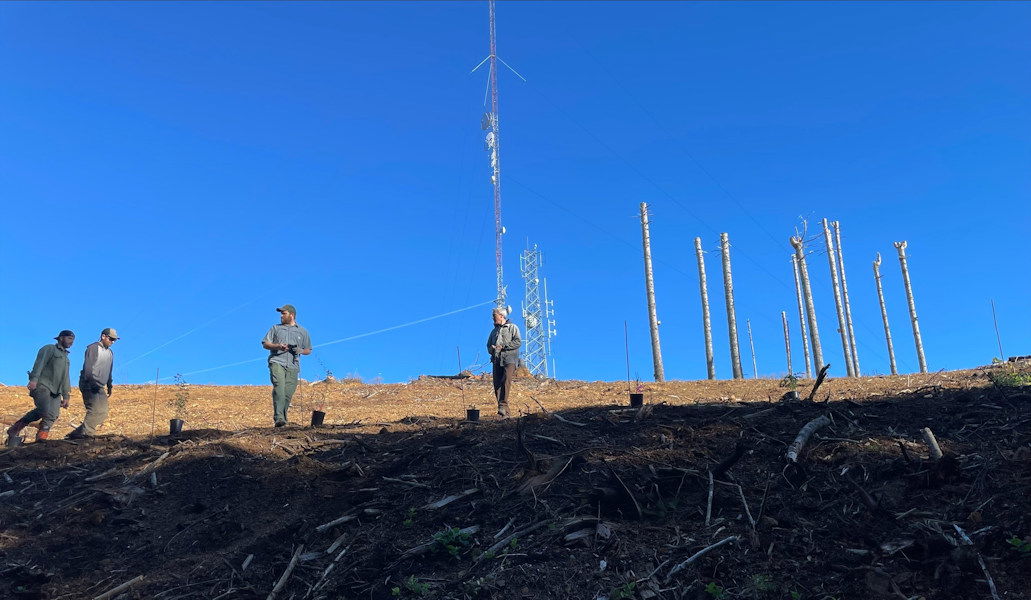Wildlife benefits from unique state agency partnership to enhance critical habitat

VENETA, Ore. (KTVZ) -- Purple martins, bats, bees and other common and uncommon wildlife are seeing benefits of a high-elevation meadow in the Oregon Coast Range, established through a joint effort between the Oregon Department of Forestry and the Oregon Department of Fish and Wildlife.
The four-acre Walker Meadows site is located about 13 miles west of Veneta, at an elevation of 2,300 feet.
“It’s at the top of Walker Point, where there are three communication towers and an ODF smoke detection camera,” said Randy Smith, ODF Wildlife Biologist. “The 2020 wildfires prompted discussion for options to remove timber to reduce fire risk and also limit damage to infrastructure from falling trees from the 84-year-old timber stand on the point.”
The local district office and area biologists came up with a plan for a timber sale to remove six acres of trees. But after safety concerns were addressed for the critical communication towers, they also wanted to improve habitat for wildlife in the area.
“Of special interest to us were retaining three patches of larger diameter conifer trees,” said Smith. “These trees were topped during harvest operations to create replacement snags for a nearby small colony of western purple martins whose existing snag habitat was quickly degrading. They nest in those snags after woodpeckers create cavities, so they are critical.”
While the timber harvest was underway, ODFW asked if there were any suitable sites for an upland meadow at a regular end-of-season meeting between the two departments.
“It was great timing,” said Jason Kirchner. ODFW district biologist. “Many different species, including numerous Oregon Conservation Strategy species, are supported by montane grassland habitats. Pollinators, such as the Western Bumblebee and other invertebrates, rely on Kincaid’s Lupine, Nelson’s Checkermallow, and other rare endemic wildflower species found in montane grassland.”
However, to turn a timber harvest area into a montane grassland-type meadow required a lot of work.
“The district coordinated the timber sale,” said Chet Behling, ODF Assistant District Forester based in Veneta. “We burned the slash piles and other unwanted woody debris then chemically treated the noxious and invasive plants. Typically, after a timber harvest, all the stumps are left to naturally decay. But in this case, they had to be removed — something we seldom do.”
ODFW applied for and received grant funding to remove the stumps. A contractor removed 4.3 acres of stumps and leveled the ground to make the area ready for replanting.
“ODF applied to the Xerces Society for some free Oregon Monarch and Pollinator Habitat Kits—and we were successful in obtaining 120 potted plants for the new meadow habitat,” said Smith. “Staff from both agencies got together and did the planting. ODFW staff then seeded the rest of the meadow with a native pollinator/grass seed mix.”
All the planting and seeding was done last October, and the meadow is looking good this year.
“Multiple species, including Western Bluebirds, Pileated Woodpeckers, Olive-sided Flycatcher, California Myotis, Fringed Myotis, Hoary Bats, and Silvered-hair Bat, have all been documented exploiting the forest openings for feeding,” said Kirchner. “Also, meadows like this have optimal forage for small and large mammals such as moles, voles, rabbits, bobcats, Roosevelt elk, black-tailed deer, mountain lions, and black bears.”
Although the meadow supports a wide range of species, Smith has a special interest in the purple martins that nest nearby.
“They are the largest member of the swallow family in North America,” said Smith. “They rely on cavities in snags to nest so that is a big limiting factor on their population.”
To aid in the birds' nesting, boxes were placed on the snags in the meadow area. The boxes are easily removable for maintenance and to aid in the potential banding of the birds.
“Little was known about their winter migration until recently,” said Smith. “In 2020, a martin was banded and fitted with a GPS tag in Florence and recaptured in 2021. The data was amazing—the bird made an 8,000-mile trip from the Oregon coast to southeast Brazil and back.”
Smith hopes to establish a colony at Walker Meadow and continue the research.
“A future goal is to band and track birds that nest here,” said Smith. "In 2023, we had birds in the area, but none nested. This year, many more martins have been observed in the area, but none have been documented nesting. We do, however, have western bluebirds and tree swallows nesting this year.”
Both ODFW and ODF see this meadow as a model project that can be used as a guide to create more critical habitat.
“Our hope is that other local ODF districts can create more places like this, for all our wildlife,” said Smith. “Often, people do not realize how hard ODF works to monitor, protect and enhance habitat for not just threatened and endangered species, but for all the wildlife in our state forests.
For more information on ODF’s efforts see the State Forests webpage under the heading of “Conservation and Restoration.”
For more information on ODFW, see their Wildlife Division website.
For more on the mission of the Xerces Society, see their website.